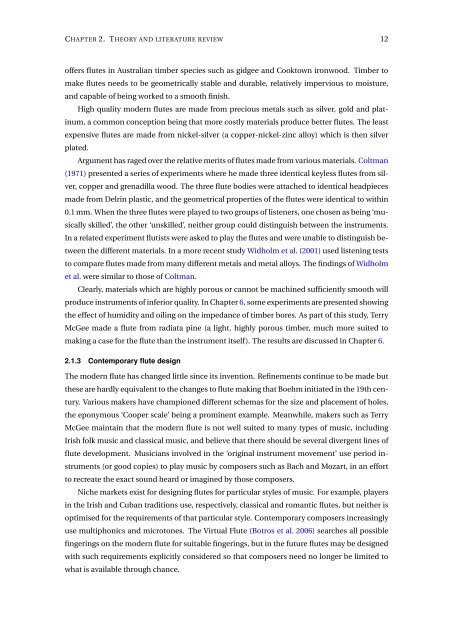Flute acoustics: measurement, modelling and design - School of ...
Flute acoustics: measurement, modelling and design - School of ...
Flute acoustics: measurement, modelling and design - School of ...
You also want an ePaper? Increase the reach of your titles
YUMPU automatically turns print PDFs into web optimized ePapers that Google loves.
CHAPTER 2. THEORY AND LITERATURE REVIEW 12<br />
<strong>of</strong>fers flutes in Australian timber species such as gidgee <strong>and</strong> Cooktown ironwood. Timber to<br />
make flutes needs to be geometrically stable <strong>and</strong> durable, relatively impervious to moisture,<br />
<strong>and</strong> capable <strong>of</strong> being worked to a smooth finish.<br />
High quality modern flutes are made from precious metals such as silver, gold <strong>and</strong> platinum,<br />
a common conception being that more costly materials produce better flutes. The least<br />
expensive flutes are made from nickel-silver (a copper-nickel-zinc alloy) which is then silver<br />
plated.<br />
Argument has raged over the relative merits <strong>of</strong> flutes made from various materials. Coltman<br />
(1971) presented a series <strong>of</strong> experiments where he made three identical keyless flutes from silver,<br />
copper <strong>and</strong> grenadilla wood. The three flute bodies were attached to identical headpieces<br />
made from Delrin plastic, <strong>and</strong> the geometrical properties <strong>of</strong> the flutes were identical to within<br />
0.1 mm. When the three flutes were played to two groups <strong>of</strong> listeners, one chosen as being ‘musically<br />
skilled’, the other ‘unskilled’, neither group could distinguish between the instruments.<br />
In a related experiment flutists were asked to play the flutes <strong>and</strong> were unable to distinguish between<br />
the different materials. In a more recent study Widholm et al. (2001) used listening tests<br />
to compare flutes made from many different metals <strong>and</strong> metal alloys. The findings <strong>of</strong> Widholm<br />
et al. were similar to those <strong>of</strong> Coltman.<br />
Clearly, materials which are highly porous or cannot be machined sufficiently smooth will<br />
produce instruments <strong>of</strong> inferior quality. In Chapter 6, some experiments are presented showing<br />
the effect <strong>of</strong> humidity <strong>and</strong> oiling on the impedance <strong>of</strong> timber bores. As part <strong>of</strong> this study, Terry<br />
McGee made a flute from radiata pine (a light, highly porous timber, much more suited to<br />
making a case for the flute than the instrument itself). The results are discussed in Chapter 6.<br />
2.1.3 Contemporary flute <strong>design</strong><br />
The modern flute has changed little since its invention. Refinements continue to be made but<br />
these are hardly equivalent to the changes to flute making that Boehm initiated in the 19th century.<br />
Various makers have championed different schemas for the size <strong>and</strong> placement <strong>of</strong> holes,<br />
the eponymous ‘Cooper scale’ being a prominent example. Meanwhile, makers such as Terry<br />
McGee maintain that the modern flute is not well suited to many types <strong>of</strong> music, including<br />
Irish folk music <strong>and</strong> classical music, <strong>and</strong> believe that there should be several divergent lines <strong>of</strong><br />
flute development. Musicians involved in the ‘original instrument movement’ use period instruments<br />
(or good copies) to play music by composers such as Bach <strong>and</strong> Mozart, in an effort<br />
to recreate the exact sound heard or imagined by those composers.<br />
Niche markets exist for <strong>design</strong>ing flutes for particular styles <strong>of</strong> music. For example, players<br />
in the Irish <strong>and</strong> Cuban traditions use, respectively, classical <strong>and</strong> romantic flutes, but neither is<br />
optimised for the requirements <strong>of</strong> that particular style. Contemporary composers increasingly<br />
use multiphonics <strong>and</strong> microtones. The Virtual <strong>Flute</strong> (Botros et al. 2006) searches all possible<br />
fingerings on the modern flute for suitable fingerings, but in the future flutes may be <strong>design</strong>ed<br />
with such requirements explicitly considered so that composers need no longer be limited to<br />
what is available through chance.
















